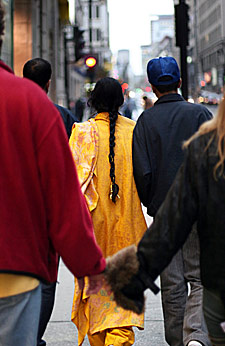A. Introduction: the issue
Australia is one of the freest countries in the world for the holding and expressing of religious beliefs and behaviours, especially when compared with the widespread denials of religious freedom of in so many nations today.
A recent survey Report 2000 On Religious Freedom In the World presents us with an unhappy picture of serious and oppressive restrictions; in most Muslim countries, in those nations of the former USSR dominated by one Christian church, in the few remaining communist nations such as China, and even in some European nations like France and Greece with their anti sect laws. It might seem churlish then to raise concerns about relatively minor threats to liberty here when there is so much more that is troubling overseas. However, the issues of freedom in our society are still important. Interestingly the preface of Report 2000 itself focuses on a particular kind of danger to religious liberty in liberal democracies.

Good intentions don't always lead to good outcomes. In his book Why Things Bite Back: Technology and the Revenge Effect Edward Tenner gives examples of technologies that, under certain conditions, had the exact opposite effect of what they were intended to have; computerised offices that see a drop in productivity because of the extra work computers cause, antibiotics which lead to more virulent diseases, improved padding and helmets in American Football leading to more injury, and so on.
Public policy can have same effect. There is a growing recognition that under certain circumstances the provision of state welfare can actually increase the human misery it is designed to alleviate. Could the same dynamic be working in the protection of religious freedom?
In the last 50 years we have witnessed a remarkable growth in laws purporting to protect religious freedom in Western countries as part of the increased interest in human rights since the horror of the last world war. George Weigel in the last Acton Lecture showed how the Christian Church has been a major defender of human rights in the last part of the 20th Century and outlined how this change has come particularly thanks to the ministry of John Paul II. It was a very positive picture.
Yet not all has been so rosy, even here in Australia. A number of recent proposals for human rights legislation have represented real threats to the freedom of religion in this country. Fortunately, after significant outcries, final outcomes have been much less problematic than first proposals. But the threat to freedom represented by law reform commissions and anti discrimination boards should be of concern to lovers of liberty, irrespective of religious convictions or their absence.
B. What is religious freedom?
Let us begin with article 18 of The International Covenant on Civil and Political Rights [adopted by the United Nations in 1966, and ratified by Australia in 1980]. The first clause sets out the basic rights.
1. Everyone shall have the right to freedom of thought, conscience and religion. This right shall include freedom to have or to adopt a religion or belief of his choice, and freedom, either individually or in community with others and in public or private, to manifest his religion or belief in worship, observance, practice and teaching.
Religious freedom is not just freedom to think certain things, but to act on them, in concert with others. The later UN "Religion Declaration" Article 6 is valuable in unpacking further freedoms included in this freedom, including freedoms to assemble, maintain appropriate buildings, establish and maintain appropriate charitable institutions. The second clause of the International Covenant on Civil and Political Rights sets out the important condition that these freedoms necessarily involve a freedom from coercion.
Importantly for our discussion, religious freedom is not absolute. The third clause spells out the appropriate limits to these freedoms saying thay must be subject to what is "necessary to protect public safety, order, health, or morals or the fundamental rights and freedoms of others'. To pre-empt my discussion to come, a goal of maintaining social harmony, for example is not a valid justification for the government to impose a limit on religious freedom. Of course, we all wish to live in a tolerant, harmonious and happy society, as well as a free one. The question is how much, if at all, should the government use legislation to ensure such a society, and how much social goals of tolerance and equality when, legally enforced, endanger freedom. In wrestling with this question we should certainly bear in mind the afore mentioned law of unintended consequences.
To download a complete copy of this paper as a pdf file, click the link below:
Dangerous Protections
















